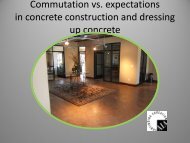- Page 1 and 2:
Abstracts 1 ABSTRACTS
- Page 3 and 4:
Contents 4 Foreword 5 Welcome from
- Page 5 and 6:
Welcome From College of Engineering
- Page 7 and 8:
Roger Fosdick Department of Aerospa
- Page 9 and 10:
Invariants in Nonlinear Elasticity
- Page 11 and 12:
Coarse-Graining Atomistic Dynamics
- Page 13 and 14:
Fracture Behavior of Mechanophore-L
- Page 15 and 16:
Stability of periodic media under c
- Page 17 and 18:
Three Dimensional Compressible Mult
- Page 19 and 20:
Experimental and Modeling Study to
- Page 21 and 22:
Thermoresponsive Microcapsules for
- Page 23 and 24:
Shear Activation of Mechanophore-Li
- Page 25 and 26:
Room Temperature Healing of a Therm
- Page 27 and 28:
Collagen Fibrils: Multifunctional N
- Page 29 and 30:
Tianxiang Su Mechanical Engineering
- Page 31 and 32:
Understanding the Influence of Stra
- Page 33 and 34:
Thermodynamic Based Higher-Order Gr
- Page 35 and 36:
35 ABSTRACTS
- Page 37 and 38:
where is the heating rate. Derivati
- Page 39 and 40:
Oxidation and Hole Formation in Alu
- Page 41 and 42:
Effect of surface tension and energ
- Page 43 and 44:
A Computational Framework for Micro
- Page 45 and 46:
45 ABSTRACTS
- Page 47 and 48:
It has been suggested that air bubb
- Page 49 and 50:
Fig. 2. Melting temperature vs part
- Page 51 and 52:
Quantifying the Effect of Pulsatile
- Page 53 and 54:
Error analysis for 3-D shape measur
- Page 55 and 56:
To test the effects of the ultrasou
- Page 57 and 58:
Surface Coverage and Hybridization
- Page 59 and 60:
Track 1 Horner Symposia 59 ABSTRACT
- Page 61 and 62:
A 3D Pseudo-Elastic Model for Mulli
- Page 63 and 64:
Analytical Solutions for the Onset
- Page 65 and 66:
References [1] J. D. Humphrey. Nati
- Page 67 and 68:
Analysis of Stiffness Variations in
- Page 69 and 70:
Indentation of a Nonlinear Viscoela
- Page 71 and 72:
Linear Theory for the Bending and S
- Page 73 and 74:
Buckling and Finite Deformation of
- Page 75 and 76:
Remarks on the Infinitesimal Stabil
- Page 77 and 78:
finite characteristic dimensions, t
- Page 79 and 80:
On Mathematics in Ray Ogden's Contr
- Page 81 and 82:
Superposition of Finite-Amplitude S
- Page 83 and 84:
Stability of Electro Active Polymer
- Page 85 and 86:
Modelling of Electro-Viscoelasticit
- Page 87 and 88:
The Vibration Induced Dissipative H
- Page 89 and 90:
Arterial Modeling Considering the M
- Page 91 and 92:
A Two-Scale Collagen Turn-Over Mode
- Page 93 and 94:
Statistical Non-Linear Fibre-Reinfo
- Page 95 and 96:
A Model of Growth and Mass Transfer
- Page 97 and 98:
Reading the Mechanical Response of
- Page 99 and 100:
Fundamental Solution in Plane Aniso
- Page 101 and 102:
Simply Unreal: Grassmann Hypercompl
- Page 103 and 104:
Influence of Fiber Dissolution and
- Page 105 and 106:
On the electro-mechanical response
- Page 107 and 108:
On the Importance of Counterion Con
- Page 109 and 110:
Stewart Silling Sandia National Lab
- Page 111 and 112:
On the Modeling of Rheological Beha
- Page 113 and 114:
Acoustoelastic Measurement of Surfa
- Page 115 and 116:
Time permitting, we consider the Ta
- Page 117 and 118:
Effect of Nonlinearity on the Stead
- Page 119 and 120:
Is Step-Flow Epitaxy Ever Stable? M
- Page 121 and 122:
Entropy of a Constrained Hamiltonia
- Page 123 and 124:
The Volume Derivative and Fracture
- Page 125 and 126:
The Anomalous Behavior of Material
- Page 127 and 128:
Energy Release Rate of Dielectric M
- Page 129 and 130:
SYMPOSIUM 2-2 Cell Mechanics ORGANI
- Page 131 and 132:
study to show the highly three-dime
- Page 133 and 134:
Chemomechanics at the Cell-material
- Page 135 and 136:
Interplay between Cell and Matrix S
- Page 137 and 138:
A Coarse-Grain Molecular Dynamics M
- Page 139 and 140:
Contact Mechanics of Circular Membr
- Page 141 and 142:
Fibroblast Elongation, Dendritic Ex
- Page 143 and 144:
Applying Controlled Loads to Single
- Page 145 and 146:
An Overview of Vibro-Acoustography
- Page 147 and 148:
Fracture between Molecules Kenneth
- Page 149 and 150:
Investigation of Skull Hemorrhage a
- Page 151 and 152:
Uncovering Morphological and Morpho
- Page 153 and 154:
Microcantilever Based Aptameric Nan
- Page 155 and 156:
Fluid-Structure Interaction Models
- Page 157 and 158:
Anaylzing Range of Motion in Total
- Page 159 and 160:
Direct Measurement of Plastic Dissi
- Page 161 and 162:
The Influence of Screw Thread and T
- Page 163 and 164:
Static Evaluation of Shear Loading
- Page 165 and 166:
during 5000 test cycles, load drop
- Page 167 and 168:
Nanomechanics of Tropocollagen and
- Page 169 and 170:
Hip Implant Interfacial Motion, a F
- Page 171 and 172:
Mapping Tibial Surface Strains usin
- Page 173 and 174:
Bone Isotropy Characterization Unde
- Page 175 and 176:
Effects of Anthropometric Geometry
- Page 177 and 178:
On Stress Theory for Fractal Bodies
- Page 179 and 180:
The Kinetic Relation as a Pivotal P
- Page 181 and 182:
Creasing Instability in Soft Matter
- Page 183 and 184:
Inverse Stress Analysis in AAA Cons
- Page 185 and 186:
Experimental and Modeling Study to
- Page 187 and 188:
Material Analysis for the Developme
- Page 189 and 190:
Experimentally Verified Approach fo
- Page 191 and 192:
A Long-Pulse Kolsky Bar Technique f
- Page 193 and 194:
Active Porous Scaffolds for Control
- Page 195 and 196:
Sensor Behavior of Magneto-Rheologi
- Page 197 and 198:
Slipping Plane Plasticity using the
- Page 199 and 200:
Internal Fluctuation of DNA in Nano
- Page 201 and 202:
Carmel Majidi Harvard University, S
- Page 203 and 204:
Coupling of Localized Buckling Defo
- Page 205 and 206:
An Energy-Based Approach to Capture
- Page 207 and 208:
A Theory of Actuation of Ionic Poly
- Page 209 and 210:
Three-Dimensional Imaging of Crysta
- Page 211 and 212:
In-situ Reconstruction of Tip-sampl
- Page 213 and 214:
TRACK 3 Fluid Mechanics 213 ABSTRAC
- Page 215 and 216:
Alan Wineman Comments on the Career
- Page 217 and 218:
Numerical Solutions in Nonlinear Ma
- Page 219 and 220:
Mathematical Modeling of a New Clas
- Page 221 and 222:
Mixture Theory to Study Blood Flow
- Page 223 and 224:
Phase Field Theory for Phase Transf
- Page 225 and 226:
Nonlocal Gradient-Dependent Constit
- Page 227 and 228:
On Unsteady Non-homogenous Flows of
- Page 229 and 230:
Fluid Dynamics of the Deepwater Hor
- Page 231 and 232:
SYMPOSIUM 3-2 Dynamics and Rheology
- Page 233 and 234:
Modeling and Homogenization of Bact
- Page 235 and 236:
Dynamics of a Semi-flexible Polar F
- Page 237 and 238:
Dense Cellular Blood Flow in a Mode
- Page 239 and 240:
Drag, Diffusive Motion, and Mixing
- Page 241 and 242:
SYMPOSIUM 3-3 Experimental Fluid Me
- Page 243 and 244:
Population, Characteristics and Kin
- Page 245 and 246:
The Effect of Particle Concentratio
- Page 247 and 248:
A Hybrid Simulation of Continuum an
- Page 249 and 250:
An Experimental Study of Pulsed Mic
- Page 251 and 252:
SYMPOSIUM 3-5 Fluid Issues in Renew
- Page 253 and 254:
Influence of Cylinder Aspect Ratio
- Page 255 and 256:
Numerical Investigation of Aerodyna
- Page 257 and 258:
SYMPOSIUM 3-8 Multiphase Flow ORGAN
- Page 259 and 260:
Three Dimensional Compressible Mult
- Page 261 and 262:
Numerical Simulation of Gust Respon
- Page 263 and 264:
SYMPOSIUM 4-1 Nanomechanics: Beyond
- Page 265 and 266:
Nano Adhesion and Indentation Kenne
- Page 267 and 268:
Atomistic Mechanisms of Cyclic Hard
- Page 269 and 270:
Broadband Nanoindentation Spectrosc
- Page 271 and 272:
Importance of AFM Beam Dynamics for
- Page 273 and 274:
Quantitatively Exploring the Mechan
- Page 275 and 276:
Effect of Scales and high Temperatu
- Page 277 and 278:
Experimental and Model Developments
- Page 279 and 280:
Controlled Carbon Nanotube Junction
- Page 281 and 282:
Understanding the Influence of Stra
- Page 283 and 284:
Temperature and Strain Rate Sensiti
- Page 285 and 286:
The Influence of Chemical Substitut
- Page 287 and 288:
Non-Uniqueness in Energy Minimizati
- Page 289 and 290:
Coarse-Graining Atomistic Dynamics
- Page 291 and 292:
simulations will also be discussed,
- Page 293 and 294:
Dislocation Cores in Elastically An
- Page 295 and 296:
SYMPOSIUM 4-3 Strain Rate Effects i
- Page 297 and 298:
Dynamic-Tensile-Extrusion in Low Im
- Page 299 and 300:
Wave Profile Shaping for Shock-Tube
- Page 301 and 302:
SYMPOSIUM 4-4 Size Scale Effects in
- Page 303 and 304:
Atomistic and Continuum Understandi
- Page 305 and 306:
Physical Interpretation and Experim
- Page 307 and 308:
Tensile Ductility and Plasticity Me
- Page 309 and 310:
A New Nonlocal Shell Model for Axis
- Page 311 and 312:
Effect of Surface Roughness and Fun
- Page 313 and 314:
An Analysis of the Effects of Surfa
- Page 315 and 316:
A SEM Image-based Finite Element Ap
- Page 317 and 318:
SYMPOSIUM 4-5 Phase Transformations
- Page 319 and 320:
Modeling and Simulation of Strain-i
- Page 321 and 322:
Nanovoid Nucleation Inside Elastopl
- Page 323 and 324:
Molecular Dynamics Study of Thermal
- Page 325 and 326:
Effect of Surface Tension and Energ
- Page 327 and 328:
A bi-crystal Aggregate Model of Mar
- Page 329 and 330:
SYMPOSIUM 4-6 Multifunctional Compo
- Page 331 and 332:
Electrified Carbon Fiber Polymer Ma
- Page 333 and 334:
Thermal and Mechanical Properties o
- Page 335 and 336:
Carbon Nanotube Buckypaper Material
- Page 337 and 338:
Effective Parameters of Bucky Gel M
- Page 339 and 340:
Influence of Surface Roughness and
- Page 341 and 342:
Microvascular Networks for Thermal
- Page 343 and 344:
Henghua Jin University of Illinois
- Page 345 and 346:
A High Temperature Cured Structural
- Page 347 and 348:
Autonomic Structural Cooling via Ad
- Page 349 and 350:
Pressurized Vascular Systems for He
- Page 351 and 352:
Photovoltaic Waveguide Polymer Comp
- Page 353 and 354:
Effect of Silane Coupling Agent on
- Page 355 and 356: Crushing Behavior of Composite Hexa
- Page 357 and 358: Degradation Kinetics of Aerospace W
- Page 359 and 360: Multiscale Modeling of Micro/nano S
- Page 361 and 362: [1] Y.A. HUANG, Z. YIN, A. TESFAMIC
- Page 363 and 364: Quantitative Nondestructive Evaluat
- Page 365 and 366: A Multiscale Model of Rate Dependen
- Page 367 and 368: Localization Analysis of Porous Met
- Page 369 and 370: Negative Stiffness and Negative Poi
- Page 371 and 372: Failure Surfaces for Fiber-Reinforc
- Page 373 and 374: Nonlocal Boundary Layer Method for
- Page 375 and 376: An Exact Solution for History-Depen
- Page 377 and 378: Development of an Internal State Va
- Page 379 and 380: A Study of Highly Crosslinked Epoxy
- Page 381 and 382: Convergence and Scaling in Peridyna
- Page 383 and 384: Graphene Fracture Kyug-Suk Kim Brow
- Page 385 and 386: A Computational Framework for Micro
- Page 387 and 388: Measurement of Mechanical Propertie
- Page 389 and 390: The Role of Electrons in Nanostruct
- Page 391 and 392: Thermoresponsive Microcapsules for
- Page 393 and 394: Elastic Softening of Amorphous and
- Page 395 and 396: Autonomic Restoration of Conductivi
- Page 397 and 398: Response of Composite Structures to
- Page 399 and 400: Lateral Vibration of a Travelling T
- Page 401 and 402: Shear Activation of Mechanophore-Li
- Page 403 and 404: Cooling Effects on the Vibronic Ban
- Page 405: Dynamoic Damage Tolerance of Aerona
- Page 409 and 410: Ab initio Simulation of Photo-disso
- Page 411 and 412: Laser Texturing of Polyimide for Al
- Page 413 and 414: Surface Modification of Titanium Vi
- Page 415 and 416: Coating Deposition via Insertion of
- Page 417 and 418: Laser Resonant Vibrational Excitati
- Page 419 and 420: Femtosecond Laser Fabrication of Ne
- Page 421 and 422: Multi-fluid Model of Early-stage Fe
- Page 423 and 424: Track 6 Nondestructive Evaluation o
- Page 425 and 426: Developments in Testing and Health
- Page 427 and 428: High Volume, Remote Sensing, Non-in
- Page 429 and 430: Development and Application of Magn
- Page 431 and 432: A Performance Measure for Ceramic A
- Page 433 and 434: Probing Acoustic Nonlinearity using
- Page 435 and 436: Ultrasonics of Periodic Structures
- Page 437 and 438: Nanoscale Interfacial Probing of Ru
- Page 439 and 440: Laser Ultrasonic Thermometry for In
- Page 441 and 442: Physics-based Analysis of Infrared
- Page 443 and 444: Acoustic Characteristics Measuremen
















